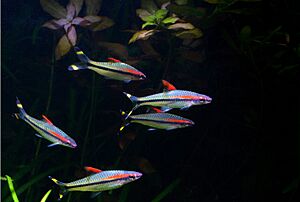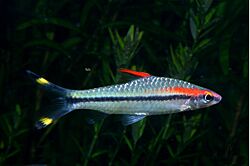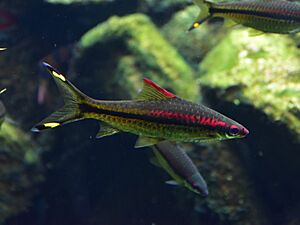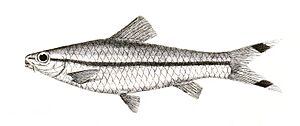Denison barb facts for kids
Quick facts for kids Denison barb |
|
|---|---|
 |
|
| Conservation status | |
| Scientific classification | |
| Synonyms | |
|
The Denison barb is a beautiful fish from India. It is also known as Miss Kerala or the red-line torpedo barb. Its scientific name is Sahyadria denisonii.
This fish lives only in the fast-flowing streams and rivers of the Western Ghats in India. Sadly, it is an endangered species. This means there are not many left in the wild. A big reason for this is that too many were caught for pet aquariums.
Contents
What Does It Look Like?
The Denison barb has a sleek, torpedo-shaped body. Its scales are shiny silver. A bright red line runs from its nose, through its eye, and along its side. Below this red line, there is a black line that goes all the way to its tail.
As the fish gets older, a special green or blue mark appears on top of its head. These fish can grow up to about 15 centimeters (6 inches) long. However, they are usually between 9 to 11 centimeters (3.5 to 4.3 inches) long. They are very active fish and like to swim together in groups called shoals.
A scientist named Francis Day first described this fish. He named it after Sir William Denison.
Where Do They Live and What Are Their Dangers?
Denison barbs are found only in a few rivers in India. These include the Achenkovil, Pamba, and Chaliyar rivers. They live in rocky pools where there are lots of plants along the riverbanks. They like warm water, between 18 to 26 degrees Celsius (65 to 79 degrees Fahrenheit).
Scientists have found that too many Denison barbs were being caught. This was mainly for the pet aquarium trade. This over-collecting is the biggest threat to them. Even though local reports said the fish was endangered, some groups still promoted it for export.
The Denison barb became very popular in the aquarium hobby. By 2007-2008, it made up a large part of India's live ornamental fish exports. The government of Kerala state has banned fishing for and exporting this fish. But it is not yet protected by a national law in India. There was once a rare golden type of this fish, but it is now gone from the wild. A few hobbyists still have them in their home aquariums.
Keeping Them in Aquariums
The Denison barb is a fairly new fish for people who keep aquariums. They are schooling fish, which means they prefer to live in groups. It's best to keep several of them together. They are usually peaceful fish. However, they can sometimes be a bit aggressive when food is around. This happens more if they don't have enough space.
They eat many different things. This includes bloodworms, shrimp, meat, fish flakes, and some plant material. There is a similar fish called Sahyadria chalakkudiensis. Sometimes people confuse it with the Denison barb. But the Sahyadria chalakkudiensis is bigger, less colorful, and more aggressive.
Breeding Efforts
For many years, people tried to breed Denison barbs in captivity. This was important because their numbers were dropping in the wild. At first, it was hard to get them to breed.
In 2009, a breakthrough happened at the Fisheries College in Kerala, India. A person named Bony Joseph successfully bred them. Other groups, like Chester Zoo and two hobbyists from Chennai, also had success. These efforts are very helpful. They show how to breed the fish, which helps both conservation and the pet fish trade. Now, many Denison barbs are being bred in special facilities.
See also
- List of freshwater aquarium fish species
- Indian Fish Breeds List





